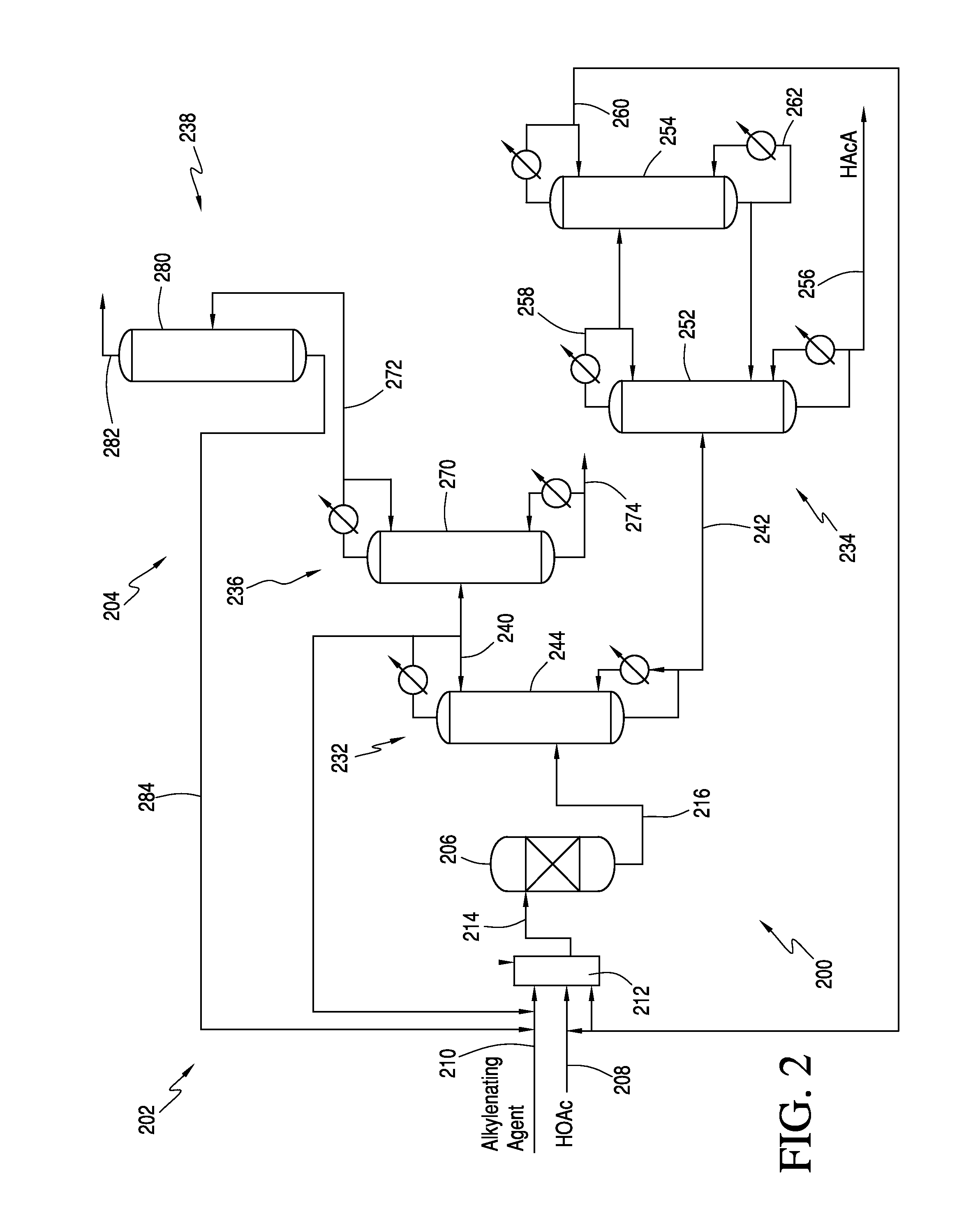Processes for the production of acrylic acids and acrylates from a trioxane feed
a trioxane feed and acrylic acid technology, applied in the field of production of acrylic acid, can solve the problems of process degradation, process inefficiency, explosion risk,
Inactive Publication Date: 2013-09-17
CELANESE INT CORP
View PDF39 Cites 6 Cited by
- Summary
- Abstract
- Description
- Claims
- Application Information
AI Technical Summary
Benefits of technology
The invention relates to a process for producing an acrylate product. This process involves reacting a reaction mixture containing an alkanoic acid and an alkylenating agent composition under specific conditions to form a crude acrylate product. The alkylenating agent composition includes at least one ring-structured compound with at least two oxygen atoms and one carbon atom. The process also involves separating the crude acrylate product to create a purified acrylate product stream. This invention provides a simplified and efficient way to produce acrylate products.
Problems solved by technology
These processes have become obsolete for economic, environmental, or other reasons.
Although this process may show some improvement over earlier processes, this process suffers from production and / or separation inefficiencies.
In addition, this oxidation reaction is highly exothermic and, as such, creates an explosion risk.
As a result, more expensive reactor design and metallurgy are required.
Also, the cost of propylene is often prohibitive.
The acetic acid conversions in the disclosed references, however, may leave room for improvement.
Method used
the structure of the environmentally friendly knitted fabric provided by the present invention; figure 2 Flow chart of the yarn wrapping machine for environmentally friendly knitted fabrics and storage devices; image 3 Is the parameter map of the yarn covering machine
View moreImage
Smart Image Click on the blue labels to locate them in the text.
Smart ImageViewing Examples
Examples
Experimental program
Comparison scheme
Effect test
example 1
[0198]Reaction mixtures comprising trioxane, oxygen, and acetic acid were reacted over a catalyst in accordance with the present invention. The molar ratio of acetic acid to trioxane was approximately 1.5:1. The gas hourly space velocity was 600 hr−1. The reaction temperature was 370° C. The conversions, selectivities, yields were measured at various time periods.
the structure of the environmentally friendly knitted fabric provided by the present invention; figure 2 Flow chart of the yarn wrapping machine for environmentally friendly knitted fabrics and storage devices; image 3 Is the parameter map of the yarn covering machine
Login to View More PUM
| Property | Measurement | Unit |
|---|---|---|
| wt % | aaaaa | aaaaa |
| wt % | aaaaa | aaaaa |
| wt % | aaaaa | aaaaa |
Login to View More
Abstract
In one embodiment, the invention relates to a process for producing an acrylate product. The process comprises the step of reacting a reaction mixture comprising an alkanoic acid and an alkylenating agent composition under conditions effective to form a crude acrylate product. The alkylenating agent composition comprises at least 1 wt % of a ring-structured compound comprising at least two oxygen atoms and at least one carbon atom, e.g., trioxane and / or tetraoxane. The process further comprises the step of separating at least a portion of the crude acrylate product to form at least one alkylenating agent stream and at least one purified acrylate product stream comprising acrylate product.
Description
CROSS REFERENCE TO RELATED APPLICATIONS[0001]This application is a continuation-in-part of U.S. patent application Ser. No. 13 / 251,623, which was filed on Oct. 3, 2011. The entirety of this application is incorporated by reference herein.FIELD OF THE INVENTION[0002]The present invention relates generally to the production of acrylic acid via the aldol condensation reaction of an alkanoic acid and an alkylenating agent. More specifically, the present invention relates to the use of a specific alkylenating agent.BACKGROUND OF THE INVENTION[0003]α,β-unsaturated acids, particularly acrylic acid and methacrylic acid, and the ester derivatives thereof are useful organic compounds in the chemical industry. These acids and esters are known to readily polymerize or co-polymerize to form homopolymers or copolymers. Often the polymerized acids are useful in applications such as superabsorbents, dispersants, flocculants, and thickeners. The polymerized ester derivatives are used in coatings (in...
Claims
the structure of the environmentally friendly knitted fabric provided by the present invention; figure 2 Flow chart of the yarn wrapping machine for environmentally friendly knitted fabrics and storage devices; image 3 Is the parameter map of the yarn covering machine
Login to View More Application Information
Patent Timeline
 Login to View More
Login to View More Patent Type & Authority Patents(United States)
IPC IPC(8): C07C67/00C07B35/00
CPCC07C51/353C07C57/04
Inventor MUELLER, SEANNAGAKI, DICKPETERSON, CRAIG J.CHAPMAN, JOSEFINA T.
Owner CELANESE INT CORP
Features
- Generate Ideas
- Intellectual Property
- Life Sciences
- Materials
- Tech Scout
Why Patsnap Eureka
- Unparalleled Data Quality
- Higher Quality Content
- 60% Fewer Hallucinations
Social media
Patsnap Eureka Blog
Learn More Browse by: Latest US Patents, China's latest patents, Technical Efficacy Thesaurus, Application Domain, Technology Topic, Popular Technical Reports.
© 2025 PatSnap. All rights reserved.Legal|Privacy policy|Modern Slavery Act Transparency Statement|Sitemap|About US| Contact US: help@patsnap.com



